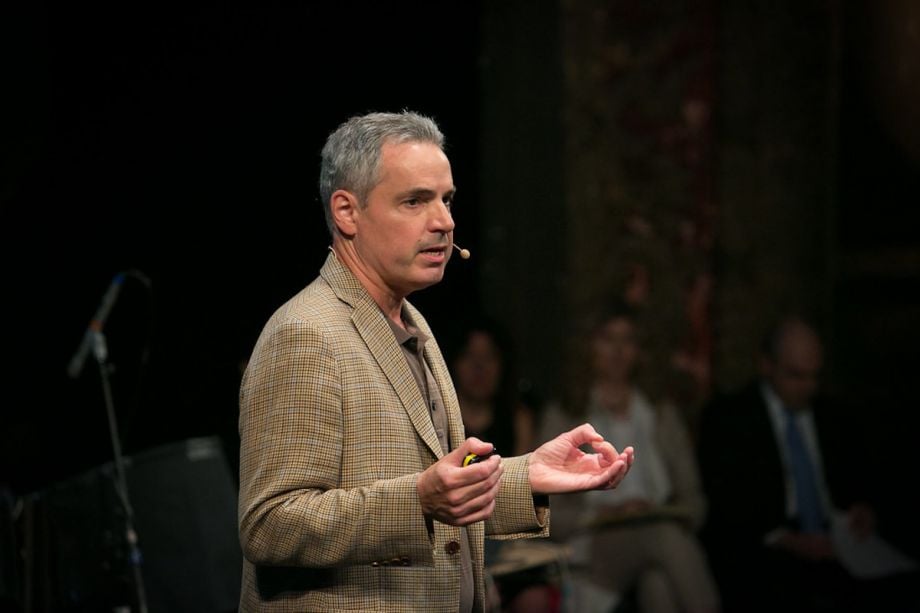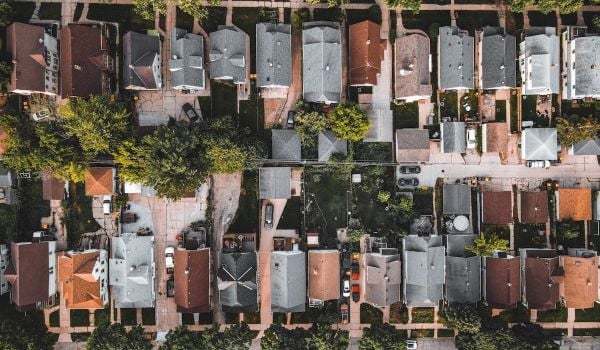This interview was originally published on Vital City.
To read Robert Sampson is to have the curtain pulled back on the gears that make our neighborhoods whir and go — and sometimes stick in tragic dimensions; on the lives of our neighbors and on the connections, thick and mainly thin, that bind us together. He is a sharp observer of the social currents of history that shape our streets and ourselves — and how all of these things come together and inhabit our everyday.
Sampson is a Harvard University sociologist who has spent the better part of his life on the great questions of urban life: violence, poverty, race, crime and equity. His answers have helped shape our understanding of how society works. Coining the term “collective efficacy,” Sampson brought rigor to Jane Jacobs’ insight about “eyes on the street,” showing how the willingness or unwillingness of neighbors to intervene on behalf of one another is a strong indicator of the level of violence in a community. He has revealed how “sticky” the character of a place is, enduring from generation to generation despite the flows of people, and indeed imprinting itself on its residents — the “neighborhood effect.”
In meticulous detail, he has demonstrated how disadvantage concentrates in a few places, with deep impacts especially in the lives of Black and Latino Americans, including literally entering their bodies: for example, the disproportionate levels of lead in children and the attendant effects on learning and achievement.
All of this combines to create the conditions in which violence can take root. The effects of violence, in turn, reverberate through generations. For example, high levels of violence have a direct effect on school achievement.
This distress is not just stuck in place: a neighborhood’s well-being is not simply about its own conditions but also affected by the neighborhoods its residents visit and are visited by. This “triple disadvantage” is a highly distilled indicator of high homicide rates.
A theorist of cities, Sampson develops his ideas through a deep commitment to empiricism. If the ideas about how society works sound inchoate, he has developed a specific way to measure them: ecometrics. In a massive longitudinal study on Chicago neighborhoods, he interviewed 9,000 residents in 300 neighborhoods, videotaping the physical conditions of 22,000 blocks, and he has been following the progress of a cohort of people from those neighborhoods for 40 years. In his most recent work on “triply disadvantaged” neighborhoods, he analyzed data from nearly 32,000 neighborhoods and 9,700 homicides in the nation’s 37 largest cities.
A man of enormous personal modesty, the honors bestowed on him from around the world are anything but; they include the Stockholm Prize, considered the Nobel of criminology. He has written widely about his work, including his capstone book, “Great American City.”
He sat down with Vital City last month to talk about his work and the life of cities.
The conversation has been edited for length and clarity.
Your theoretical work is backed by such deep empirical work. The most famous is perhaps your Chicago study that started in the 1990s, at the peak of homicides, and is still going on.
That’s the Project on Human Development in Chicago Neighborhoods. Now, why neighborhoods? Spatial inequality has long been a key feature of cities, actually going back to ancient cities. It’s a fundamental feature of urban life. Inequality is persistent, and it varies across multiple dimensions. It’s not just poverty, which we might think of initially, or racial segregation, but also crime, violence, housing quality, environmental toxicity. Our goal was to measure these and other social characteristics of neighborhoods at the same time that we were studying the kids growing up in them. It was really this dual focus: individual development, while taking seriously the neighborhood context.
We tried to create a science of assessing community. Through surveys, we interviewed residents and asked them about their neighborhoods. We paired that with two other kinds of data collection. One was systematic social observation, where we literally videotaped every street. We wanted to “see” the city and measure it in a scientific sense so we could compare that with what people tell us about, say, disorder and garbage in the streets. The other was a key informant study, where we talked to community leaders. These three tools were the empirical backdrop of what we called community “ecometrics.”
The theoretical framing was what sociologists call social organization and, in particular, informal social controls. The notion is that peaceful communities are peaceful not because there are cops on every corner, but because of everyday interactions and relationships. We felt that we could measure them systematically. If you’re going to take part in a community activity — maybe a community cleanup or work at the local school, or maybe saying something to local kids who are causing trouble in the community — that’s usually something that takes place under conditions of mutual trust.
What we did was think about the coalescence of cohesion and control in communities of trust, though not necessarily a deep-rooted trust. It’s akin to the idea of weak ties as opposed to close friendships. It’s trust and cohesion combined with the willingness of residents to intervene in the community for the public good. That’s what we were getting at with the term “collective efficacy.”
We asked people, for example, what would your neighbors do if kids were skipping school and hanging out in the street and causing trouble? What if the local fire station were about to be closed down? Would your neighbors get together to do something about it? Do you trust your neighbors?
We created a scale of collective efficacy from such items, which was highly reliable and predicted lower rates of crime and violence even after controlling for poverty, prior crime and other commonly studied factors. We published a paper on that back in the ’90s, and there has been a lot of work since then testing the theory. Indeed, communities that are poor or burdened by, let’s say, high rates of past violence have lower rates of collective efficacy.
We still see that a lower rate of collective efficacy is a very strong predictor of crime, but it has also been shown to relate to other aspects of human well-being and health.
So what builds collective efficacy? What manufactures it? It seems like a lot of times, it’s organic. Neighbors get together because there’s a shooting on the block. But is there something more durable that can be done to build those loose connections that make for collective efficacy?
It’s a great question. And I think you put your finger on it two ways. One is the trigger of a larger challenge. It could be an earthquake, it could be a shooting, and sometimes people rise to the occasion to take action. Just like Black Lives Matter did. But collective capacity also comes from rather prosaic, everyday interactions and social ties.
Relationships are built out of everyday activities, not so much with the purpose of building something broader. Let’s say you have a bake sale for the PTA or the kids’ basketball team or for a church or whatnot. To the extent that people are engaged in shared tasks, a certain kind of cohesiveness is built.
I lived in New York for several years, and I’m sure you’ve had the experience where you go by the same person at a newsstand or coffee shop regularly, with nodding relationships. There’s a sense of who’s a regular and who’s not, even in a dense urban environment. That’s another kind of collectiveness. Eyes on the street, as Jane Jacobs would have put it.
What, then, would be a structural predictor of those kinds of activities and shared sense of community? Well, the longer you’ve lived in a neighborhood, the more likely you are to engage in local activities. Economic resources matter too, to the extent that people have time and the ability to engage in these events. Homeownership is another structural predictor.
I have tried to build a theory that says what you want to do is stabilize and invest in communities so that you provide the economic and housing and resource opportunities, but also so that you provide or incentivize shared tasks.
Those connections potentially create a virtuous cycle, right? So neighbors can mobilize to get more resources from government deployed in their neighborhoods, and make them better.
Absolutely. And that’s one of the reasons we asked about the fire station closing, or the school closing, or the park. The extent to which people can engage — that, I think, is really important. And that’s what we’ve tried to tap into.
You’re the godfather of the analysis of neighborhood disadvantage and how it clusters. Your most recent work is around what you call triply disadvantaged neighborhoods. What are they, and what’s the connection to violence?
I’ve challenged myself on the idea of neighborhood because there’s a tendency to view them as islands or isolated units. But we don’t live just in our neighborhoods. We go beyond to work, we visit friends, we go to sports events, we visit family, we go to restaurants or a museum.
Neighborhoods have flows of people coming in and going out all the time. The idea was to be able to look at how they intersect to affect the character of the neighborhood.
For example, most of the work on racial segregation up to a few years ago was based on the isolation of the neighborhood based on its racial characteristics relative to the rest of the metropolitan area. What we did was measure the movement of people from a given neighborhood to all other neighborhoods in the metropolis and then visits into the neighborhood. From that, we created new measures of racially segregated mobility in the 50 largest American cities.
We also conceptualized neighborhood disadvantage in the following way: We measured the poverty of a neighborhood, and then we took all the visits into that neighborhood from other neighborhoods around the city, and the poverty rates of those neighborhoods, so we could get at what network theorists call the in-degree, or inflow, of disadvantage. And then we measured where residents were going and the poverty rates of those visited neighborhoods. That’s the out-degree of disadvantage.
The combination of all three we called “triple disadvantage” — it’s a neighborhood that’s poor, its residents visit other poor neighborhoods and the residents flowing into the neighborhood are from other poor neighborhoods. What we found is that triple disadvantage was an important predictor of homicide.
The flip side allowed us to see how wealth and advantage are also highly clustered in their mobility-based contacts. There is a certain kind of isolation in triply advantaged areas that’s not just geographic.
Read the full interview on Vital City.
Elizabeth Glazer is the founder of Vital City. Most recently, she served as the director of the New York City Mayor’s Office of Criminal Justice where she led the strategy to produce a dramatic reduction in the jail population and to create community-led safety strategies. She previously oversaw the criminal justice agencies in New York State as the governor’s deputy secretary for public safety. She is a former federal prosecutor and clerked for then-U.S. Circuit Court Judge Ruth Bader Ginsburg.
















